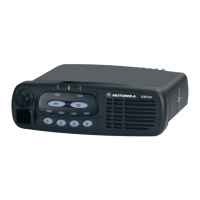
Do you have a question about the Motorola GM Series and is the answer not in the manual?
| Channels | 16 |
|---|---|
| Waterproof | No |
| Frequency Range | VHF: 136-174 MHz |
| Signaling | DTMF, MDC1200 |
| Dimensions | 56 x 175 x 218 mm |
Provides instructions for safe and efficient operation of Motorola Portable and Mobile Two-Way Radios.
Details compliance with standards and guidelines regarding human exposure to RF electromagnetic energy.
Guidance on optimal radio performance and human exposure to RF energy during mobile operation.
Precautions to prevent interference with vehicle braking systems during radio installation.
Procedures to test for radio interference with the vehicle braking system.
Warning to turn off radio in potentially explosive areas to prevent ignition.
Warning to turn off radio near blasting caps to avoid interference with operations.
Provides an overview of installation methods and accessory connections for the radio.
Details how to select an optimal location for mounting the radio unit in a vehicle.
Instructions for routing and connecting the DC power cable to the vehicle's electrical system.
Steps for mounting the radio using the standard trunnion bracket.
Guidance on mounting the antenna, including EME exposure and site selection.
Details various methods for mounting the radio, including dashboard and external speaker installations.
Description of pin functions for the accessory connector and connection plans.
Explains how electrical noise affects mobile radio operation and the importance of noise suppression.
Identifies the three major noise sources affecting mobile radio systems: radiated, conducted, and induced noise.
Describes radiated noise entering the radio through the antenna, often from ignition systems or motors.
Explains conducted noise entering through attachment points to the vehicle's electrical system.
Details noise signals induced into radio cabling due to proximity with other vehicle wiring.
Explains the basic operation of an automobile ignition system for understanding interference causes.
Overview of the ignition system's role in igniting gasoline vapor and air mixture.
Details how the secondary circuit of the ignition coil causes interference.
Methodical procedures for identifying offending noise sources using equipment like pick-up loops.
Steps to detect noise by moving a pick-up loop or using bypass capacitors for trial-and-error.
Discusses geographic location, accessory operation, and ignition systems as potential noise sources.
Overview of three basic methods for suppressing noise: resistance, filtering, and static control.
Describes basic noise suppression methods and the value of vehicle service manuals.
Addresses engine tune-up, noise reduction kits, and ignition coil interference.
Methods to suppress high-pitched whine from alternators or generators using capacitors.